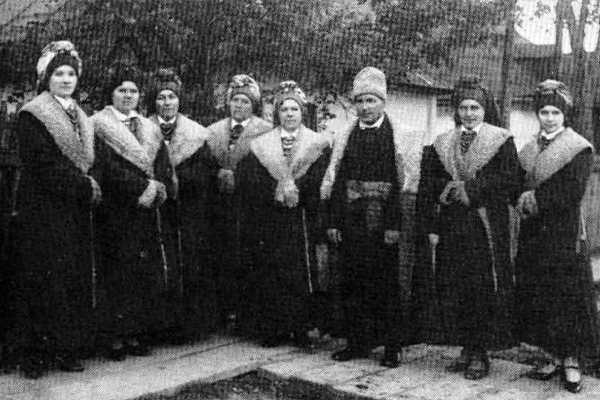Uhniv lower middle-class people, the middle-class between the intelligentsia (university/institute graduates) and the peasantry, were very proud of their bourgeois status and observed all their customs and traditions that are several hundreds of years old. The style of dress in Uhniv was rather unique in the whole of Galicia.
The men’s apparel consisted earlier of linen and later of factory-made fabric shirt with double collar without any tie, trousers of dark cloth, a black vest and frock coat (surdut), hand-made high yuft boots made of leather called “uhnivtsi”. Later they wore box calf boots or shoes. In the summer, the men wore a black broad-cloth coat, a long one almost down to their ankles. They also wore black cloth hats. Earlier they wore black or brown bowler hats.
For winter, they wore a sheepskin coat with the black collar, which was wide, laid out reaching all the way to the chest. When there was garnet cloth on the sheepskin, it was lined with gray or dark sheepskin with the same Crimean collar.
The sheepskin coat had no buttons. Black sheepskin coat they matched with a black sheepskin hat and garnet one – with a gray sheepskin hat. Earlier men used to wear tall hats (see photo dated 1887). It was a half meter high sheepskin hat, the sides of which were sewn on the binding, and the sheepskin was tied on both sides with ribbons. The bottom was made of velvet. The unbuttoned sheepskin coat was worn overlapping its sides and girded with a belt. In old times, the lower middle-class people girded themselves with gold-stitched Slutsk belts. Later, the Slutsk belts became obsolete due to their high price.
The women’s dress consisted of a blouse with a high starchy double collar, Uhniv yuft boots later box calf or chevrette boots and later in the summer they wore low shoes which they called «tsizhmy», a wide skirt with pleads of different colours, most often flowery, and dressy apron in front. In addition, women also wore a “katsabaika”, in the summer made of single cloth and in the winter - quilted one. In the summer, they wore a “kaftanyk”- a long, wide cloak with take-ups on the back. In the wintertime, they wore a “futryna” - a wide cloak made of black cloth, lined with white sheepskins. The “futryna” was long almost down to their ankles, tight to the waist, wide from the waist to the hem. The collar was made of the same cloth. It was wide. The “futryna” had no buttons, it was like an overlapped coat. They girded the “futryna” with Ukrainian traditional black and red woven belt called “kraika”. On bigger holidays, women wore frog coats. It is an outer garment, sewn like a “futryna”, however, in garnet cloth. The frog coat was hemmed up with gray fur, the collar was wide and made of gray krymka, laid out. The sleeves wrists were hemmed up with gray hem, 7-8 centimeters wide. There was also a gray “krymka” on the sides of the waist, two fingers wide and up to 10 inches long. It was hemmed up from the shoulder to the waist with golden cloth. Such clothes were expensive. Before the First World War, it cost 200 Austrian crowns.
The Uhniv women wore a big so-called Turkish shawl, the area of which was about 4 square meters. They tied it over the forehead into a fancy knot, and the two ends of the shawl fell on the shoulders up to the shoulder blades.
Women wore original strings for necklace. Depending on financial status, they had 3-12 strings for necklace on their chests. In the middle of the necklace there was/were attached one or two gold ducats (ducats since the time of Empress Maria Theresa).
Each lower middle-class woman had several skirts and several large shawls. For different holidays they wore a shawl of a specific colour: at Christmas (silver), at the Epiphany (blue), at Easter and Ascension Day (green); fasting, wedding, mourning, etc. They brought these shawls from Damascus. From a material and artistic viewpoint , they represented a great treasure.
(the original text, taken from the book THE CITY OF UHNIV AND ITS REGION)
photo - A group of Uhniv women wearing winter clothes (photo: summer 1934)

